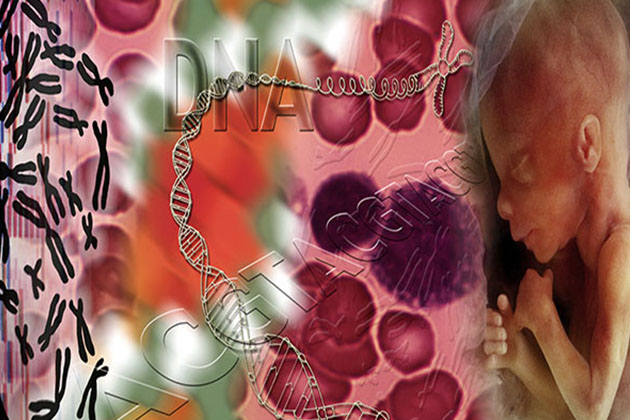Исследование показывает перспективность лечения генетических заболеваний у млекопитающих во время внутриутробного развития плода в первые три месяца беременности.
A генетический расстройство - это состояние или заболевание, которое вызвано аномальными изменениями или мутациями ДНК человека в гене. Наш ДНК provides the required code for making proteins which then perform most of the functions in our body. Even if one section of our DNA gets altered in some way, the protein associated with it can no longer carry out its normal function. Depending upon where this change happens either it can have a little or no effect or it might alter the cells so much that it could then lead to a генетический disorder or illness. Such changes are caused by errors in DNA replication (duplication) during growth, or environmental factors, lifestyle, smoking and exposure to radiation. Such disorders are passed on to the offspring and start to occur when the baby is developing in mother’s uterus and are therefore referred to as ‘birth defects’.
Birth defects can be minor or extremely severe and may affect appearance, function of an organ and some aspect of physical or mental development. Millions of children are born annually with serious генетический conditions. These defects can be detected during pregnancy as they are evident within the first three months of pregnancy when the organs are still forming. A technique called amniocentesis is available for detecting генетический abnormalities in the foetus by testing amniotic fluid extracted from the uterus. However, even with amniocentesis, treating them is not possible as no options are available to make any corrections before birth of the baby. Some of the defects are harmless and require no intervention but some others can be of serious nature and may require long-term treatment or even be fatal for the infant. Some defects can be corrected shortly after birth of the baby – example within a week’s time – but mostly it is too late for treatment.
вулканизация генетический condition in an unborn baby
For the first time the revolutionary gene editing technique has been used to cure a ‘генетический disorder’ in mice during foetal development in the uterus in a study by researchers at Carnegie Mellon University and Yale University. It is well established that during early development in the embryo (during first three months of a pregnancy) there are many stem cells (an undifferentiated cell type which can become any type of cell upon maturation) that are dividing at a fast rate. This is the pertinent time point where a генетический mutation if corrected would reduce the impact of the mutation on embryo-to-foetal development. There are chances that a severe генетический condition could even be cured and the baby is born without the unintended birth defects.
В этом исследовании, опубликованном в Природа связи researchers have used a peptide nucleic acid-based gene editing technique. This technique has been used before to treat beta thalassemia – a генетический blood disorder in which haemoglobin (HB) produced in the blood is reduced considerably which then affects normal oxygen supply to various parts of the body leading to severe abnormal consequences. In this technique, unique synthetic molecules called peptide nucleic acids (PNAs) (made of a combination of synthetic protein backbone with DNA and RNA) were created. A nanoparticle was then used to transport these PNA molecules along with “healthy and normal” donor DNA to the location of a генетический mutation. The complex of PNA and DNA identifies the designated mutation at a site, PNA molecule then binds and unzips the double helix of mutated or faulty DNA. Lastly, donor DNA binds with the mutated DNA and automates a mechanism to correct the DNA error. The main significance of this study is that it was done in a foetus, thus researchers had to use a method analogous to amniocentesis wherein they inserted the PNA complex into the amniotic sac (amniotic fluid) of pregnant mice whose foetuses were carrying the ген мутация, вызывающая бета-талассемию. После одной инъекции PNA исправилось 6 процентов мутаций. У этих мышей наблюдалось улучшение симптомов заболевания, то есть уровни гемоглобина были в пределах нормы, что можно было интерпретировать как «излечение» мышей от этого состояния. Они также показали повышенную выживаемость. Эта инъекция была в очень ограниченном диапазоне, но исследователи надеются, что можно будет достичь еще более высоких показателей успеха, если инъекции будут сделаны несколько раз.
Исследование актуально, потому что не было замечено никаких отклонений от цели, и была исправлена только желаемая ДНК. Хотя методы редактирования генов, такие как CRISPR / Cas9, проще использовать для исследовательских целей, они все еще вызывают споры, потому что они разрезают ДНК и выполняют внешние ошибки, поскольку они также повреждают нецелевую нормальную ДНК. Из-за этого ограничения они не идеально подходят для разработки методов лечения. Принимая во внимание этот фактор, метод, показанный в текущем исследовании, связывается только с целевой ДНК и восстанавливает ее, не допуская ошибок за пределами площадки. Это целевое качество делает его идеальным для терапевтических целей. Такой метод в его нынешней конструкции также потенциально может быть использован для «лечения» других состояний в будущем.
{Вы можете прочитать исходную исследовательскую работу, щелкнув ссылку DOI, приведенную ниже в списке цитируемых источников}
Источник (ы)
Ricciardi AS et al. 2018. Внутриутробная доставка наночастиц для сайт-специфичного редактирования генома. Природа связи. https://doi.org/10.1038/s41467-018-04894-2






































